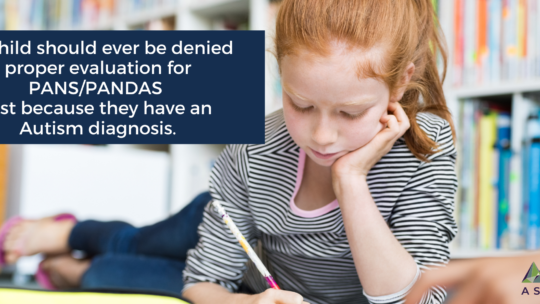Blog
Implementing dietary changes with children affected by PANS/PANDAS
Khimani, Kynza & Abadía-Barrero, César & LaRusso, Maria. (2024). Implementing dietary changes with children affected by PANS/PANDAS. Children’s Health Care. 1-19. 10.1080/02739615.2024.2338763.
- 64.7% of the 467 survey participants indicated that a healthcare provider recommended dietary changes as part of PANS/PANDAS treatment.
- 55.7% of the families did implement dietary changes
- 69.6% reported at least one diet to be somewhat effective in helping with PANS/PANDAS symptoms
- 36% reported dietary changes to be very effective, particularly gluten-free and sugar-free diet
- Some parents and clinicians highlighted children’s resistance to new diets and concerns about worsening OCD and food-restrictive disorders as barriers to implementing dietary changes

When Infection Sparks Obsession: PANDAS and PANS
When Angela Tang’s teenage son came down with a baffling illness, few households could have been better equipped to deal with it. The family lives in a wealthy Los Angeles suburb. Both parents are...

Birmingham, Alabama Chit Chat Meet Up
ASPIRE ChitChat - Birmingham, Alabama - Tuesday, May 14, 2024 - 6:30 PM...

Montgomery, Alabama ChitChat Meet Up
ASPIRE ChitChat - Montgomery, Alabama - Monday, May 6, 2024 - 6:00 PM CDT...

Toolkit – PANS/PANDAS Guidelines for Children with Autism
ASPIRE’S Professional Advisory Board publishes PANS/PANDAS Guidelines for Children with Autism PANS PANDAS & Autism Autism PANS Guidelines Children who have autism spectrum disorder (ASD or...

Tennessee PANS PANDAS Updates
Residents of Tennesee, we need your help! This is the first year Tennessee has undertaken legislative efforts to pass a legislative mandate to secure insurance coverage for PANS PANDAS. SB2401/HB2484...

PANDAS Family granted insurance coverage after 4th attempt
NASHVILLE, Tenn. (WSMV) - After three denials of insurance coverage of a misunderstood disease, a Mt. Juliet family just learned the good news: BlueCross BlueShield has agreed to three months of...
Inflammation as the Common Pathophysiology Linking Stress, Mental Illness, Autoimmunity and Chronic Disease: Implications for Public Health Policy
Kinderlehrer DA. Inflammation as the Common Pathophysiology Linking Stress, Mental Illness, Autoimmunity and Chronic Disease: Implications for Public Health Policy. J Biomed Res Environ Sci. 2024 Mar 28; 5(3): 242-255. doi: 10.37871/jbres1889, Article ID: JBRES1889, Available at: https://www.jelsciences.com/articles/jbres1889.pdf
- The article discusses the interplay between genetics, epigenetics, stress, trauma, inflammation, mental illness, autoimmunity, and chronic disease.
- While modern medicine has made significant advances in disease care,
it appears that lifestyle intervention, early childhood intervention, and socioeconomic
investment and have the potential to make an even greater impact on the mental and
physical well-being of the population. - An individual’s genetic makeup influences susceptibility to conditions, but environmental factors like stress and trauma can modify this through epigenetics.
- Chronic stress and trauma can induce epigenetic changes and dysregulate immune responses, leading to inflammation, mental illness, autoimmunity, and chronic disease.
- Lifestyle changes like exercise, diet, and toxin management can reduce inflammation and risks of mental and physical illness. Stress is a key factor and reducing stress through mindfulness, meditation, and exercise can decrease inflammation. Loneliness is a significant stressor and healthy social connections are important.
Enuresis as a presentation of Paediatric Autoimmune Neuropsychiatric Disorder Associated with Streptococcus (PANDAS)
Poster: Enuresis as a presentation of Paediatric Autoimmune Neuropsychiatric Disorder Associated with Streptococcus (PANDAS)
 Author: Ying Xin Wong, Ubhi Tim
Author: Ying Xin Wong, Ubhi Tim
Presented: The Royal College of Paediatrics and Child Health Annual Meeting, March 2023.
- Out of the total cohort of 109 children, 56 patients (51%) had enuresis as a presenting symptom alongside their PANDAS symptoms.
- Enuresis is a common presentation of children with PANDAS (observed in 51% of cases). Early recognition of enuresis is important in promptly identifying PANDAS cases allowing prompt investigation and treatment.

‘He’s falling apart’
Family enters final fight for son’s ‘life-saving’ treatment WSMV4 by Amanda Hara. Published: Mar. 21, 2024 at 5:35 PM EDT Another story about the cruel bureaucracy of insurance. A child...

Grand Rounds – Children’s Minnesota – Neuroinflammation in Children: Breaking Down Silos of Care?
GRAND ROUNDS – Register Today Children’s Minnesota will host a one-hour pediatric grand rounds presentation featuring Eyal Muscal, MD, MS. – Neuroinflammation in Children: Breaking...
